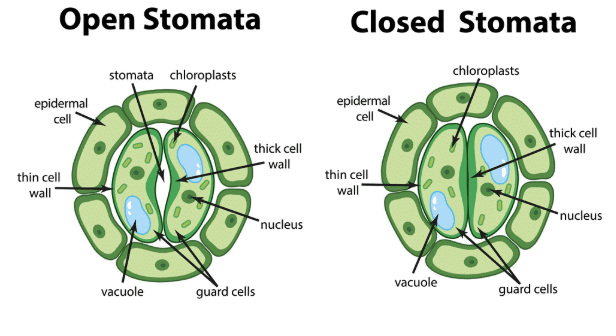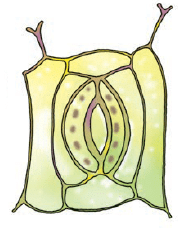NCERT Exemplar Solutions: Nutrition in Plants | Science Class 7 (Old NCERT) PDF Download
| Table of contents |

|
| Multiple Choice Questions |

|
| Very Short Answer Questions |

|
| Short Answer Questions |

|
| Long Answer Questions |

|
Multiple Choice Questions
Q.1. Organisms which prepare food for themselves using simple naturally available raw materials are referred to as
(a) heterotrophs
(b) autotrophs
(c) parasites
(d) saprophytes
Ans: b
Explanation: Organisms which prepare food for themselves using simple naturally available raw materials are referred to as autotrophs. Organisms which are dependent on plants for their food are known as heterotrophs.Parasites are those organisms which live and are dependent on the host for food. They obtain food at the cost of their host.
Organisms which are dependent on plants for their food are known as heterotrophs.Parasites are those organisms which live and are dependent on the host for food. They obtain food at the cost of their host.
Saprophytes are the organisms that eat dead and decaying matter as food.
Q.2. In the absence of which of the following will photosynthesis not occur in leaves?
(a) Guard cells
(b) Chlorophyll
(c) Vacuole
(d) Space between cells
Ans: b
Explanation: The leaves have a green pigment called chlorophyll. It helps leaves to capture the energy of the sunlight. This energy is used to synthesise (prepare) food from carbon dioxide and water.
Q.3. Which of the following statements is/are correct?
(i) All green plants can prepare their own food.
(ii) Most animals are autotrophs.
(iii) Carbon dioxide is not required for photosynthesis.
(iv) Oxygen is liberated during photosynthesis.
Choose the correct answer from the options below:
(a) (i) and (iv)
(b) (ii) only
(c) (ii) and (iii)
(d) (i) and (ii)
Ans: a
Explanation:
Statement ii) is wrong because animals are heterotrophs.
Statement iii) is wrong because CO2 is necessary for photosynthesis.
Q.4. Pitcher plant traps insects because it
(a) is a heterotroph.
(b) grows in soils which lack nitrogen.
(c) does not have chlorophyll.
(d) has a digestive system like human beings.
Ans: b
Explanation: The pitcher plant traps insects primarily because it grows in soils that are low in nitrogen. This adaptation allows it to supplement its nutrient intake by digesting insects.
Q.5. The term that is used for the mode of nutrition in yeast, mushroom and bread-mould is
(a) autotrophic
(b) insectivorous
(c) saprophytic
(d) parasitic
Ans: c
Explanation: The mode of nutrition in yeast, mushrooms, and bread-mould is known as saprophytic nutrition. This involves:
- Absorbing nutrients from dead and decaying organic matter.
- Organisms that utilise this method are referred to as saprotrophs.
- Fungi, including yeast and mushrooms, thrive on materials like bread and other decomposing substances.
Q.6. When we observe the lower surface of a leaf through a magnifying lens we see numerous small openings. Which of the following is the term given to such openings?
(a) Stomata
(b) Lamina
(c) Midrib
(d) Veins
Ans: a
Explanation:
The small openings observed on the lower surface of a leaf are known as stomata. These pores play a crucial role in the plant's ability to:
- Exchange gases, allowing carbon dioxide to enter and oxygen to exit.
- Regulate water loss through transpiration.
 Each stoma is surrounded by guard cells that control its opening and closing, thus managing the plant's gas exchange and water retention effectively.
Each stoma is surrounded by guard cells that control its opening and closing, thus managing the plant's gas exchange and water retention effectively.
Q.7. Two organisms are good friends and live together. One provides shelter, water, and nutrients while the other prepares and provides food. Such an association of organisms is termed as
(a) saprophyte
(b) parasite
(c) autotroph
(d) symbiosis
Ans: d
Explanation: The association where two organisms live together and share resources is known as symbiosis. In this relationship:
- One organism provides shelter, water, and nutrients.
- The other organism prepares and provides food.
Q.8. Which of the following raw material is available in the air for photosynthesis?
(a) Oxygen
(b) Carbon dioxide
(c) Nitrogen
(d) Hydrogen
Ans: b
Explanation: The raw material available in the air for photosynthesis is: Carbon dioxide
During photosynthesis, plants absorb carbon dioxide from the air, which is essential for producing food and oxygen.
Very Short Answer Questions
Q.9. Potato and ginger are both underground parts that store food. Where is the food prepared in these plants?
Ans: In these plants, the shoot system and the leaves stay above ground. They prepare food by photosynthesis and store energy in the underground part of the plant.
Q.10. Photosynthesis requires chlorophyll, and a few other raw materials. Add the missing raw materials to the list given below: Water, minerals, _______(a) ______, ______(b)________.
Ans:
(a) Sunlight/light energy,
(b) carbon dioxide.
Short Answer Questions
Q.11. A goat eats away all the leaves of a small plant (balsam). However, in a few days, new leaves could be seen sprouting in the plant again. How did the plant survive without leaves?
Ans: Plants have stored food in their stems and roots. Because of this plants live for few days without leaves.
Q.12. Unscramble the following to form terms related to modes of nutrition.
(i) RASPAEIT
(ii) ROPEHYTSAP
(iii) TOROPHAUT
(iv) SIBIOMSYS
Ans:
(i) PARASITE
(ii) SAPROPHYTE
(iii) AUTOTROPH
(iv) SYMBIOSIS
Q.13. Nitrogen is an essential nutrient for plant growth. But farmers who cultivate pulse crops like green gram, bengal gram, black gram, etc. do not apply nitrogenous fertilizers during cultivation. Why?
Ans: Roots of pulses has a symbiotic relationship with a bacteria called Rhizobium. This bacteria fixes atmospheric nitrogen which will be utilized by leguminous plants. Hence, farmers don’t apply nitrogen fertilizers while cultivating cereals.
Q.14. Wheat dough is left in the open, after a few days, starts to emit a foul smell and becomes unfit for use. Give reason.
Ans: Carbohydrates present in the dough will provide nutrients for the growth of yeast and other fungi. These break down glucose to emit a foul smell and spoil dough.
Q.15. Sunlight, chlorophyll, carbon dioxide, water and minerals are raw materials essential for photosynthesis. Do you know where they are available? Fill in the blanks with the appropriate raw materials.
(a) Available in the plant: _______________
(b) Available in the soil: _______________, _______________
(c) Available in the air: _______________
(d) Available during day: _______________
Ans:
(a) Available in the plant: Chlorophyll
(b) Available in the soil: Water, Minerals
(c) Available in the air: Carbon-di-oxide
(d) Available during day: Sunlight
Q.16. Observe the diagram given as Figure and label the following terms given in the box
Ans:

Long Answer Questions
Q.17. Match the organisms given in Column I with their mode of nutrition given in Column II.

Ans:

Q.18. Wild animals like tiger, wolf, lion and leopard do not eat plants. Does this mean that they can survive without plants? Can you provide a suitable explanation?
Ans: Wild animals like tigers, wolves, lions, and leopards do not eat plants. However, they rely on herbivores, which do consume plants, for their food. Here’s a breakdown of this relationship:
- Without plants, herbivores would not survive, as they depend on plants for nourishment.
- If herbivores cannot survive, then predators like tigers and lions would also struggle to find food.
- This shows that all living organisms, directly or indirectly, depend on plants for their survival.
Q.19. Fill in the blanks of the paragraph given below with the words provided in the box.
chlorophyll, energy, food, carbon dioxide, water, photosynthesis
Leaves have a green pigment called (a) which captures (b) from sunlight. This (c) is used in the process of (d) and along with other raw materials like (e) and (f) synthesize (g) .
Ans: Leaves have a green pigment called chlorophyll which captures energy from sunlight. This energy is used in the process of photosynthesis and, along with other raw materials like carbon dioxide and water, synthesizes food.
Q.20. Spot as many organisms as possible in the puzzle given as Figure by encircling them as shown. Write the names on a sheet of paper and categorise them into autotrophs and heterotrophs. Classify the heterotrophs into herbivores, carnivores, omnivores and saprophytes.
Ans:
Number of organisms: 22
(Some examples are given. You may find the rest of the organisms.)

Autotrophs – Rose, Mango, Bhindi, Carrot, Banyan, Tulsi, Ginger, Yam
Heterotrophs – Elephant, Ant, Yeast, Tiger, Mushroom, Fox, Mice, Owl, Cow, Crow, Rabbit, Bee, Fish
Herbivores – Elephant, Cow, Rabbit, Bee
Carnivores – Fox, Tiger
Omnivores – Ant, Mice, Owl, Crow, Fish
Saprophytes – Mushroom, Yeast
Q.21. Can you give me a name? Solve each of the following riddles by writing the name of the organism and its mode of nutrition. One riddle is solved to help you.
(a) I am tall but I cannot move. I am green and can prepare my own food. tree, autotroph
(b) I live in water; people keep me in an aquarium and feed me. ,
(c) I am small and I can fly. I disturb your sleep, bite you and suck your blood which is my food. ,
(d) I am white and soft. I grow well in the rainy season. Children pluck me from the ground and admire me. I absorb nutrients from decomposed dead parts of plants and animals in the soil. ,.
Ans:
(a) Tree, autotroph.
(b) fish, heterotroph
(c) mosquito, parasite
(d) mushroom, saprophyte
|
112 videos|286 docs|28 tests
|
FAQs on NCERT Exemplar Solutions: Nutrition in Plants - Science Class 7 (Old NCERT)
| 1. What is the process of nutrition in plants? |  |
| 2. How do plants absorb nutrients from the soil? |  |
| 3. What is photosynthesis and how does it contribute to plant nutrition? |  |
| 4. What are the different types of nutrition in plants? |  |
| 5. How do carnivorous plants obtain their nutrients? |  |





















